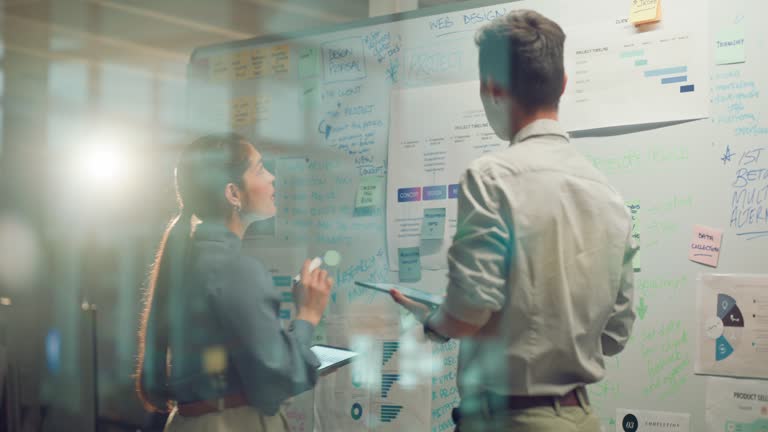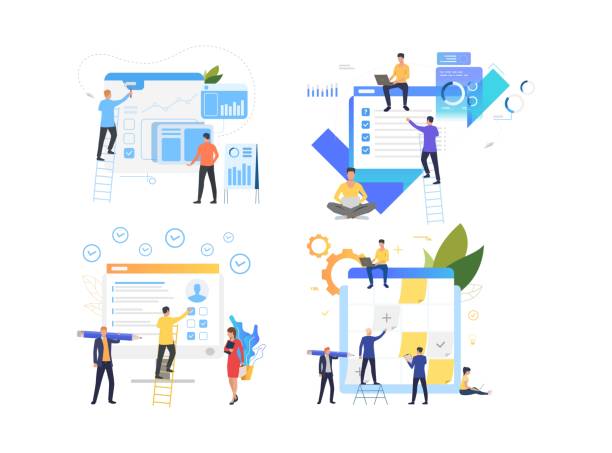Introduction and the Importance of Modern UI Website Design

In today’s digital world, where users face countless options in the web space, #website_design, #user_interface, and #user_experience are not just a competitive advantage but an undeniable necessity.
It’s no longer enough to simply have a website; rather, one must have a website that provides an enjoyable user experience and can attract and retain users.
Modern UI website design is a crucial element in creating this experience.
This approach is not limited to visual aesthetics but focuses on efficiency, ease of use, and effective user interaction.
Websites with old and inefficient user interfaces are quickly ignored by users.
Users expect websites to be fast, responsive, and visually appealing.
They seek easy navigation, accessible information, and smooth interactions.
A poor user interface can lead to an increased bounce rate, reduced user dwell time, and ultimately, the loss of potential customers.
Conversely, a modern UI website design can significantly help increase customer loyalty, improve conversion rates, and strengthen the brand.
This explains our approach to design.
Today, companies and businesses have realized that investing in creating modern user-friendly websites yields significant returns.
This is not limited to large corporations; even startups and small businesses need this to compete in the digital market.
Focusing on user needs and behaviors is the cornerstone of any successful design.
In upcoming chapters, we will delve into the principles, trends, and tools necessary to achieve this goal, guiding you on the path of modern UI website design.
Does your current site showcase your brand’s credibility as it should? Or does it scare away potential customers?
RasaWeb, with years of experience in designing professional corporate websites, is your comprehensive solution.
✅ A modern, beautiful website tailored to your brand identity
✅ Significant increase in lead and new customer acquisition
⚡ Contact RasaWeb now for a free corporate website design consultation!
Fundamental Principles of User-Friendly UI Design

User-friendly UI design goes beyond mere aesthetics and is built upon a set of fundamental principles.
One of the most important principles is visual hierarchy; meaning more important elements should appear more prominent so that users can quickly identify key information.
Using different font sizes, distinct colors, and whitespace is essential to guide the user’s eye.
Consistency is another vital principle; all buttons, icons, fonts, and colors across the website should follow a uniform style to prevent user confusion.
Feedback to the user, both visual and textual, is crucial for ensuring understanding of functionalities.
For example, changing a button’s color when clicked or displaying a success message after submitting a form.
These small details in modern UI website design make a big difference.
Accessibility is also highly important today; the website must be usable for all users, including those with disabilities.
This includes providing alternative text for images, appropriate color contrast, and keyboard navigation capability.
Simplicity and clarity are also core pillars.
Avoid clutter and adding unnecessary elements.
Every element on the page should have a clear purpose.
Our goal in modern UI design is for the user to reach their goal without much thought.
Finally, attention to scalability and responsiveness is essential for the website to display correctly on various devices (mobile, tablet, desktop).
This specialized approach to design principles forms the foundation of a successful website.
The Role of User Experience (UX) in Modern Web Design

While User Interface (UI) relates to the look and feel of a product, User Experience (UX) pertains to how a user interacts with it and their overall feeling.
UX goes beyond aesthetics and encompasses all aspects of a user’s interaction with a company, its services, and products.
In modern UI website design, focusing on UX means a deep understanding of user needs, behaviors, and motivations.
This process begins with user research, which includes interviews, surveys, and observing the behavior of actual users.
After understanding users, UX designers create personas (fictional characters representing target users) and User Journey Maps to outline potential user paths on the website.
These maps help identify pain points and opportunities for improving the experience.
Subsequently, creating wireframes and prototypes are key steps for testing and validating ideas before moving to the visual UI design stage.
This approach guides the optimization of websites with a modern perspective.
Data analysis also plays a significant role in improving UX.
Using tools like Google Analytics, user behavior can be monitored, and design strengths and weaknesses identified.
The ultimate goal of UX is for the website to not only look good but also be functional, efficient, and enjoyable.
This is an iterative and continuous process that improves with user feedback and data analysis.
Below, a comparative table between UI and UX is provided to better understand their key differences.
| Feature | User Interface (UI) | User Experience (UX) |
|---|---|---|
| Primary Focus | Website’s look and feel (colors, fonts, icons) | User’s feeling when using the website (efficiency, enjoyment) |
| Main Question | How does it look? | How does it work and how does the user feel? |
| Tools | Figma, Sketch, Adobe XD, Photoshop | User Research, Personas, User Journeys, Wireframes, Prototypes |
| Goal | Visual aesthetics and understandable interactions | Improving user satisfaction, efficiency, and accessibility |
New Trends in Modern Web UI Design

The world of modern UI website design is constantly evolving, and each year we witness the emergence of new trends that improve the user experience.
One of the most prominent recent trends is the widespread use of “Dark Mode.”
This mode is not only more comfortable for users’ eyes in low-light environments but also helps save battery on devices with OLED screens and gives the website a modern and stylish look.
This approach has gained significant popularity, especially in mobile applications and websites with long content.
Micro-interactions also play an increasing role in advanced UI design.
These small, momentary interactions, such as subtle animations when clicking a button, displaying custom loading messages, or visual feedback when entering information in a form, enrich and make the user experience more enjoyable.
They give the website a sense of responsiveness and vibrancy.
The trend towards minimalism and extensive use of white space also remains strong.
Removing unnecessary elements and focusing on core content helps users access the information they need without distraction.
This trend emphasizes simplicity, clarity, and efficiency.
The inclination to use large and bold typographies to attract attention and create a sense of modernity has also become common.
Additionally, Voice User Interfaces (Voice UI) and the use of artificial intelligence for personalizing the user experience are other emerging trends shaping the future of modern UI website design.
These developments indicate the growing need for designs that are not only beautiful but also smart, interactive, and responsive to changing user needs.
Are you losing business opportunities due to an outdated website? With RasaWeb, solve the problem of not attracting potential customers through your website forever!
✅ Attract more quality leads
✅ Enhance brand credibility in the eyes of customers
⚡ Act now for a free corporate website design consultation!
Tools and Techniques for Modern UI Website Design

To implement modern UI website design, designers need powerful tools and specific techniques.
Currently, software like Figma, Sketch, and Adobe XD are the leading tools in this field.
Figma has become very popular due to its cloud collaboration capabilities and the ability for multiple designers to work simultaneously.
Sketch is known for its strong UI design tools and rich plugin ecosystem, while Adobe XD has found its place with deep integration with other Adobe products and a focus on prototyping and animation.
Beyond tools, numerous techniques play a role in creating modern user-friendly websites.
One of the most important is the use of Design Systems.
A design system is a comprehensive set of reusable components, visual guidelines, and coding instructions that ensure consistency and efficiency throughout the design and development process.
This significantly reduces time and cost, especially in large projects and multi-team environments, ensuring all parts of the website follow a common visual language.
Another increasingly important technique is interactive prototyping.
Building prototypes that fully simulate the feel and interaction of the final product helps designers and stakeholders test and refine ideas before actual development.
This process identifies potential problems at early stages.
Also, using Pixel Grids for precise element alignment and creating consistent layouts is another common technique in modern UI website design.
Proper application of these tools and techniques paves the way for a flawless digital product.
These educational and specialized materials will help you choose the right path.
Challenges and Solutions in Modern Website Design

Despite significant advancements in the field of modern UI website design, this path is not without challenges.
One of the biggest challenges is ensuring high website performance.
Rich visual designs and complex animations can lead to slow loading times, which is frustrating for today’s users accustomed to high speed.
The solution to this challenge is optimizing images, using compressed and efficient code, and leveraging lazy loading techniques for content.
Additionally, using Content Delivery Networks (CDNs) can increase user access speed in different parts of the world.
Another challenge is accessibility.
Modern UI website design must be usable by all users, including those with visual, auditory, motor, or cognitive disabilities.
This requires adherence to standards such as WCAG (Web Content Accessibility Guidelines).
Solutions include using semantic HTML tags, appropriate color contrast, keyboard navigation capability, and providing alternative text (Alt Text) for images.
This analytical approach presents a challenging question: how can we simultaneously provide the best experience for everyone?
Cross-browser compatibility and responsiveness are also ongoing challenges.
The website must display correctly and flawlessly in all browsers (Chrome, Firefox, Safari, Edge) and on all screen sizes (mobile, tablet, desktop).
Using CSS frameworks like Bootstrap or Tailwind CSS, and frequent testing on various devices and browsers, are effective solutions in this regard.
Managing these challenges requires specialized knowledge and continuous updates to create efficient and inclusive websites.
Case Study of Successful UI Design

To gain a deeper understanding of the principles of modern UI website design, we can examine a successful case.
Let’s consider an example like the Stripe company website, a platform renowned among developers and businesses for its outstanding UI and UX design.
Stripe, with a minimalist yet informative approach, has managed to present the complexities of online finance and payments in a visually simple and understandable way.
Their website uses ample white space, clean and clear typography, and limited, purposeful color schemes.
One of Stripe’s UI design strengths is its unparalleled focus on visual hierarchy.
Key information is immediately recognizable, and guide texts are presented engagingly and concisely.
The use of subtle animations and smart micro-interactions throughout the site, especially in the product and API introduction sections, enhances the user experience and makes complex processes more pleasant.
Site navigation is highly intuitive, and users can easily access the information they need.
Stripe is also an excellent example of how to use attractive images and illustrations to reinforce brand messaging and improve content comprehension.
They use custom graphic images that explain abstract concepts in a creative and understandable way.
The website’s responsiveness across all devices is also flawless, providing a seamless user experience.
This news case study demonstrates how strong UI/UX design can directly impact not only aesthetics but also the efficiency and success of a business.
Below, you can see a table of the key features of such websites:
| Feature | Description |
|---|---|
| Minimalism and Simplicity | Removal of unnecessary elements, focus on core content and ample white space |
| Strong Visual Hierarchy | Use of size, color, and contrast to guide the user’s eye to important information |
| Smart Micro-interactions | Subtle animations and small feedbacks to improve interaction and appeal |
| Clear and Legible Typography | Selection of appropriate fonts with high readability and use of suitable sizes |
| Full Responsiveness | Full compatibility with various devices and screen sizes |
The Future of Modern UI Website Design and Artificial Intelligence

The future of modern UI website design is strongly tied to advancements in Artificial Intelligence (AI).
AI has great potential to revolutionize how we design, develop, and interact with websites.
One of the most important areas is personalization of the user experience.
Using AI algorithms, websites can tailor content, layout, and even colors based on each user’s preferences and past behavior, providing a completely unique experience.
This significantly helps increase user loyalty and conversion rates.
AI can also assist designers in the early stages of design by automatically generating layouts, color suggestions, and even selecting images.
Generative AI tools can produce initial designs at unparalleled speed, allowing designers to spend more time refining details and being creative.
These developments show that modern UI website design is moving towards becoming smarter and more automated.
Advanced chatbots and AI-powered voice assistants will also become critical tools for user interaction, transforming how information is navigated and received.
Furthermore, Augmented Reality (AR) and Virtual Reality (VR) are gradually making their way into the web space.
In the future, we may see websites that offer immersive 3D experiences, transporting users to more realistic virtual spaces.
This analytical trend of the future indicates that modern UI website design never stays static and will always move towards innovation and more advanced interactions.
Designers must constantly keep themselves updated to leverage these new technologies in creating unparalleled user experiences.
Losing potential customers due to an unprofessional website? RasaWeb is your answer! With our specialized corporate website design services:
✅ Elevate your business’s credibility and standing
✅ Experience more targeted customer acquisition
⚡ Contact us now for a free consultation!
Key Tips for Enhancing Your Website’s User Interface

Even if your website is already active, there are always opportunities to upgrade and improve its user interface to align with the standards of modern UI website design.
The first step is to listen to your users.
By conducting User Testing, you can identify pain points and issues that users experience when interacting with your website.
These tests can include usability tests, surveys, and heatmap analysis.
Direct user feedback is the most valuable resource for improvement.
Next, prioritize optimizing website loading speed.
Speed is a critical factor in retaining users and SEO ranking.
Compress images, utilize browser caching, and optimize CSS and JavaScript code.
These technical measures have a direct impact on visual experience and performance.
Also, ensure visual consistency.
Make sure all design elements – including buttons, forms, fonts, and colors – are consistent and harmonious throughout the website.
This conveys a sense of professionalism and credibility to users and prevents their confusion.
Attention to website responsiveness for various devices is essential.
Today, most users access websites via mobile, so Mobile-First Design should be a priority.
Updating content and removing old and irrelevant content also helps keep the website clean and modern.
Finally, conducting A/B tests for different UI elements, such as button colors or form placement, can help you find the best performance for your website.
These specialized guidelines will help you continuously improve your website design.
Summary and Conclusion on the Importance of Modern UI Design

In this article, we comprehensively and analytically examined the importance and dimensions of modern UI website design.
From introducing fundamental UI principles and the vital role of User Experience (UX) in website success to reviewing new trends and necessary tools for implementing this approach, we understood that modern design goes beyond visual aesthetics; it brings a combination of efficiency, accessibility, and enjoyment to the user.
This approach means building a strong bridge between your digital product and the actual needs of users.
There are numerous challenges along this path, including performance optimization and ensuring compatibility with various devices and browsers, but with appropriate solutions and the use of correct tools, they can be overcome.
Case studies of successful websites also showed how focusing on simplicity, visual hierarchy, and smart interactions can lead to brilliant results.
The future of modern UI website design also promises further developments with the advent of artificial intelligence and emerging technologies like AR/VR, which will further personalize and enrich user experiences.
Ultimately, for any business and individual aiming for a successful online presence, investing in modern UI website design is a necessity.
This not only leads to increased website aesthetics but also significantly helps improve conversion rates, increase customer loyalty, and strengthen your brand in today’s competitive market.
By considering the points and principles discussed, you can build a website that not only meets current user needs but is also ready for the future and provides an unforgettable digital experience.
Frequently Asked Questions
| Question | Answer |
|---|---|
| What is a modern user interface? | A modern user interface refers to a design that uses new trends, simplicity, excellent user experience, and attractive visual elements. |
| Why is using a modern user interface important in website design? | It attracts and retains more users, creates a sense of professionalism, improves user experience, and increases conversion rates. |
| What are the main features of a modern user interface? | Simplicity, sufficient use of white space, legible typography, attractive and harmonious colors, subtle animations, and responsive design. |
| How is responsiveness related to a modern user interface? | Responsive design is an essential feature in a modern user interface that ensures the site displays well on all devices (mobile, tablet, desktop). |
| What is the role of typography in modern user interface design? | Selecting appropriate fonts and using them correctly increases readability and contributes to the site’s aesthetic and visual identity. |
| What is White Space and why is it important in modern UI? | It is the empty space between different elements on the page that helps improve readability, user focus, and creates a sense of cleanliness and order. |
| What is the benefit of using animations in modern user interface design? | Subtle and purposeful animations can capture user attention, improve interaction, and make information transfer more engaging. |
| How can User Experience (UX) be improved alongside modern user interface? | By understanding user needs, simplifying navigation paths, providing appropriate visual feedback, and easy testability. |
| Does a modern user interface always mean using bright colors? | No, a modern user interface can use various color palettes, including dark colors. The key is choosing harmonious colors suitable for the brand. |
| What are the current trends in modern user interface design? | Using Dark Mode, Neumorphism, Glassmorphism, scroll-based animations, and minimalist design. |
And other advertising services of RasaWeb advertising agency
Smart Conversion Rate Optimization: Revolutionize user interaction with precise audience targeting.
Smart Brand Identity: Professional optimization for digital branding using Google Ads management.
Smart Google Ads: Professional optimization for campaign management using SEO-driven content strategy.
Smart Advertising Campaign: Revolutionize SEO ranking improvement with customized user experience.
Smart Google Ads: A dedicated service for increasing website traffic based on real data.
And more than hundreds of other services in the field of internet advertising, advertising consultation, and organizational solutions
Internet Advertising | Advertising Strategy | Advertorials
Resources
Top 10 Modern UI/UX Trends in 2023
Principles of Intuitive User Interface Design
Comprehensive Guide to Responsive Web Design
Best Modern Website Examples 2024
? In today’s highly competitive world, a powerful online presence is key to success. RasaWeb Digital Marketing Agency offers comprehensive and innovative solutions, including professional website design and targeted marketing strategies, to accompany your business on its path to growth and prominence.
📍 Tehran, Mirdamad Street, next to Central Bank, Southern Kazeroon Alley, Ramin Alley, No. 6


